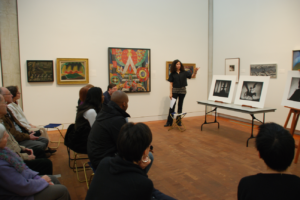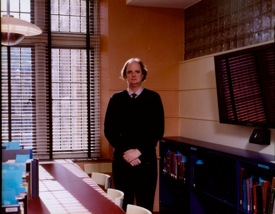
Salton Sea (T.V. Antennae), 1985
Chromogenic dye coupler print
Purchase, Friends of the Frances Lehman Loeb Art Center Fund, in honor of Claire Henriques, class of 1952
1996.5
Today’s post comes from Deborah Steinberg, class of 2014 and Art Center Student Docent.
On February 22, Professor Peter Stillman kicked off our Artful Dodger series this spring with a discussion of two photographs that expanded upon the course he taught last semester around the Sawdust Mountain exhibition at the Art Center. Richard Misrach’s Salton Sea (T.V. Antennae) and Althea Thauberger’s Dani are both photographs from the permanent collection. While initially these photographs appeared to have nothing in common, Professor Stillman pointed out that both images depicted landscapes that were altered or transformed due to human activity.
Richard Misrach’s photograph of the Salton Sea is initially disconcerting and surreal. The reflections of the antennae in the water inhibit our ability to accurately perceive the space, and as a result there is no clear foreground or background. The symmetrical bands of color in the sky and in the water come together at the thin horizon line, but all of this is cloaked by a smoggy haze that offsets the sense of space even further. Yet the whole scene is extraordinarily placid, despite the knowledge that these waters destroyed whatever was here beforehand and left everything underwater. It’s an absolutely beautiful and peaceful photograph, yet at the same time extremely bleak. It forces us to question the way the U.S. has dealt with this area and the way we are drawn to disaster. Why is this inundation beautiful?
Althea Thauberger’s photograph of Dani shows a Canadian tree planter in the middle of a cleared frontier. Like the antennae in the Salton Sea, Dani becomes a powerful vertical force contrasting the largely horizontal landscape, broken up by levels of nature: dark-brown burned lumber scraps in the foreground, followed by slightly lighter unburned wood, then grasses, brush, and finally several trees growing in the background. These levels of nature reflect the life cycle of the tree, much like we saw in the Eirik Johnson photographs in the first room of the Sawdust Mountain exhibition this past fall; and similarly, they can be read in either direction of the life cycle. As a group, we started talking about who Dani might be. On one hand, she appears strong and determined and ready to replant the entire forest and strengthen her Canadian identity as she engages with the frontier. At the same time, she is only one person and there are limits to her strength. Or is she a stand-in for the trees that were recently cleared from this landscape? If she doesn’t stand up for the environment, who will?
Professor Stillman’s course on the Sawdust Mountain exhibition was an incredible example of how the Art Center can be integrated into courses in any discipline. Professor Stillman finished his talk by describing how wonderful this opportunity had been for both him and his students, none of whom were art history majors. He explained that the Sawdust Mountain exhibition space became almost a home for them as they engaged with each of the works throughout the semester, and there was a sense of nostalgia for the collection of photographs once they had been uprooted, so to speak, at the conclusion of the exhibition. Fortunately, these wonderful photographs by Misrach and Thauberger are in our permanent collection and will always be here for anyone who wants to return home to images that evoke our often-fraught relationship with nature, landscape, and resource management.




